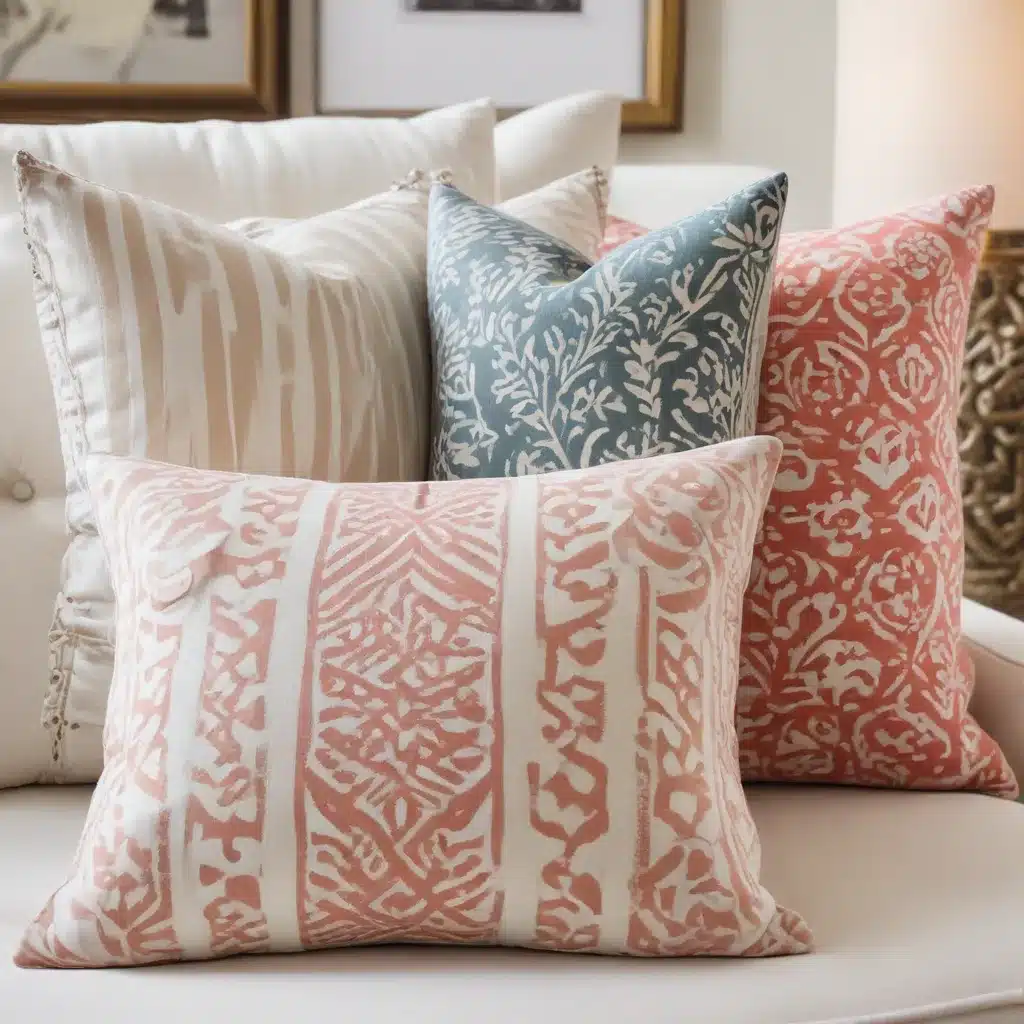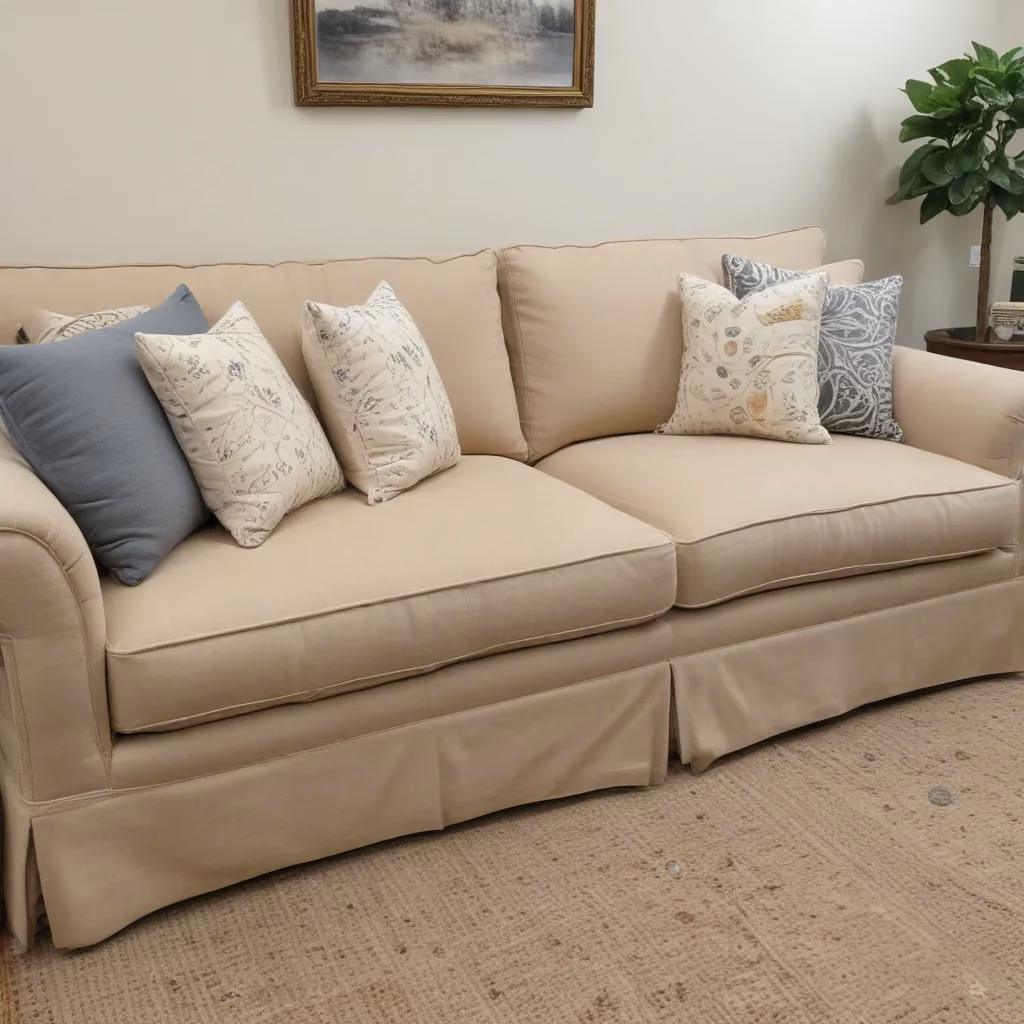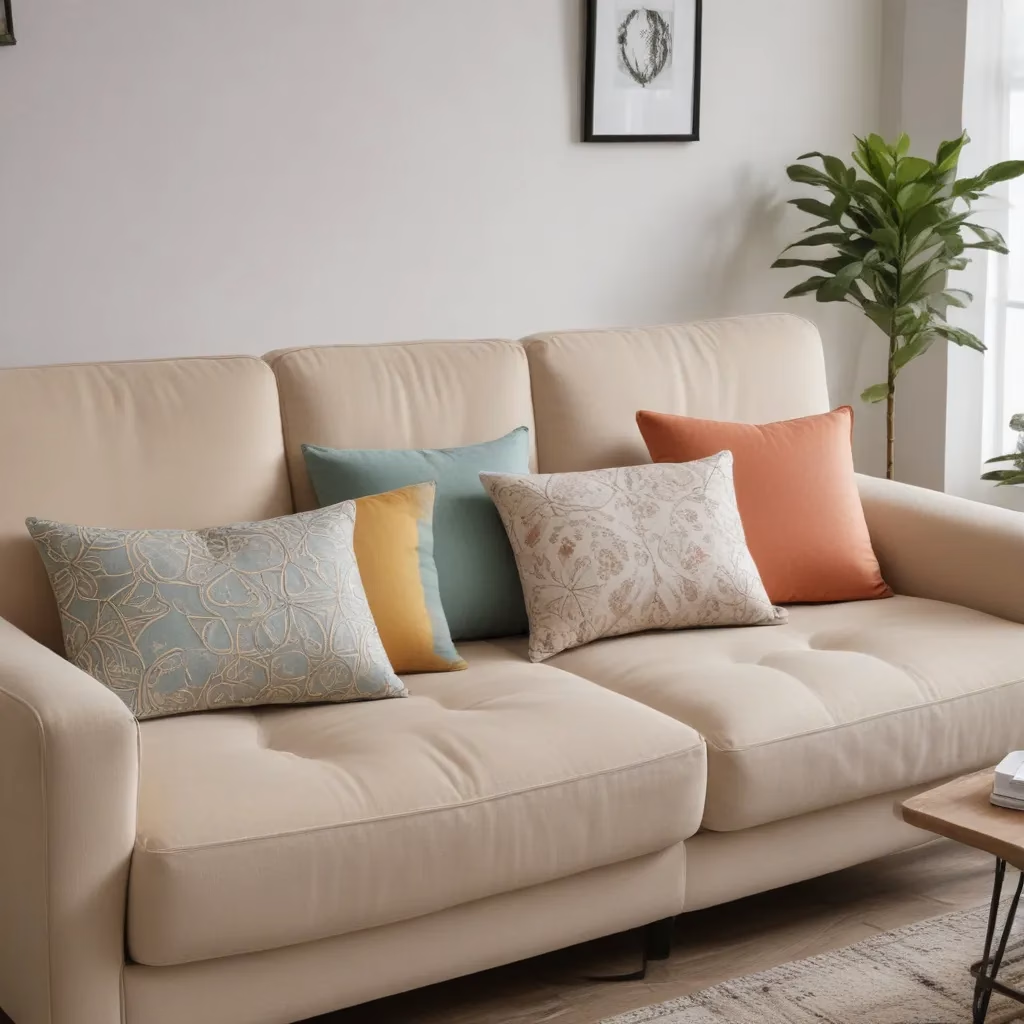
The Art of Decorative Cushions in UK Interiors
In the realm of British home decor, decorative cushions have become an essential element for adding personality and comfort to living spaces. As we approach September 2024, the trend of mixing and matching patterned accents continues to gain momentum across the United Kingdom. Homeowners and interior designers alike are embracing the creative freedom that comes with combining various textures, colours, and patterns to create visually striking and inviting environments.
The strategic use of cushions allows for easy updates to a room’s aesthetic without the need for major renovations or furniture replacements. This versatility has made decorative pillows a favourite among those looking to refresh their interiors on a budget or experiment with current design trends. From cosy cottages in the countryside to modern flats in urban centres, the art of cushion arrangement is being perfected in homes throughout the UK.
Understanding the principles of pattern mixing and cushion styling can transform an ordinary sofa into a stunning focal point. This article will guide you through the process of selecting, combining, and arranging decorative cushions to achieve a polished and professional look in your living space. Whether you’re a seasoned decorator or a novice enthusiast, these insights will help you create a harmonious and inviting atmosphere in your home.
Selecting the Right Patterns for Your Space
When it comes to choosing patterns for your decorative cushions, the options can seem overwhelming. However, by following a few key guidelines, you can create a cohesive look that enhances your interior design scheme. The first step is to consider the overall style of your room and the existing patterns present in your furnishings and decor.
For a balanced approach, interior design experts recommend working with three main types of patterns: geometric, organic, and textured. Geometric patterns include stripes, polka dots, and chevrons, which add structure and definition to your arrangement. Organic patterns, such as florals or abstract designs, bring a softer, more natural element to the mix. Textured patterns, while not always visually apparent, add depth and interest through their tactile qualities.
To achieve a harmonious look, vary the scale of your patterns. Combine large-scale designs with medium and small-scale patterns to create visual interest without overwhelming the space. For example, you might pair a large floral print with a smaller geometric pattern and a subtly textured solid colour. This approach ensures that each cushion complements the others without competing for attention.
Pattern Mixing Tips for UK Interiors
- Start with a colour scheme: Choose a palette that complements your existing decor and stick to it when selecting patterned cushions.
- Use odd numbers: Groupings of three or five cushions tend to look more visually appealing than even numbers.
- Incorporate solids: Include some solid-coloured cushions to give the eye a place to rest among the patterns.
- Consider your sofa: If your sofa is patterned, opt for cushions with simpler designs to avoid visual clutter.
- Balance bold with subtle: If you choose a statement pattern, balance it with more subdued designs in your other cushions.
By applying these principles, you can create a sophisticated and coordinated look that reflects your personal style while adhering to current UK interior design trends.
Colour Coordination in Cushion Selection
Colour plays a crucial role in the success of your cushion arrangement. The right colour scheme can tie together different patterns and create a cohesive look that enhances your overall interior design. When selecting colours for your decorative cushions, consider the existing colour palette of your room, including wall colours, furniture upholstery, and other decorative elements.
For a harmonious effect, choose cushions that feature colours already present in your space. This doesn’t mean you need to match exactly; rather, look for complementary shades or tones that work well together. If you’re feeling bold, you can introduce a new accent colour through your cushions to add a pop of interest to your room.
Colour Schemes for UK Interiors
| Colour Scheme | Description | Best Suited For |
|---|---|---|
| Monochromatic | Variations of a single colour | Modern, minimalist spaces |
| Analogous | Colours adjacent on the colour wheel | Relaxed, harmonious environments |
| Complementary | Colours opposite on the colour wheel | Vibrant, energetic rooms |
| Neutral with Accent | Neutral base with pops of colour | Versatile, easily updatable interiors |
When working with patterns, ensure that at least one colour is consistent across all your cushions to create a unified look. This common thread will help tie together even the most eclectic mix of patterns and textures.
Remember that lighting can significantly affect how colours appear in your space. Natural daylight will reveal colours most accurately, while artificial lighting can alter perceptions. Consider how your chosen colours will look at different times of day and under various lighting conditions to ensure they remain appealing throughout.
Texture: The Unsung Hero of Cushion Design
While pattern and colour often take centre stage in cushion selection, texture is an equally important element that can elevate your interior design. Texture adds depth, interest, and a tactile quality to your cushion arrangement, making your living space more inviting and comfortable.
When mixing textures, consider the contrast between smooth and rough, shiny and matte, or soft and coarse materials. This variety not only enhances the visual appeal of your cushions but also creates a more luxurious and layered look. Popular textures in UK interiors include:
- Velvet: For a touch of luxury and warmth
- Linen: Offering a relaxed, natural feel
- Wool: Perfect for adding cosiness, especially in cooler months
- Silk: Bringing a subtle sheen and elegance
- Leather: Introducing a sleek, modern element
Incorporating different textures can also help to balance bold patterns or bright colours. For instance, a heavily patterned cushion might be paired with a solid-coloured, highly textured piece to create visual harmony without overwhelming the eye.
Textural Combinations for Different Interior Styles
- Contemporary: Combine smooth leather with plush velvet for a sophisticated contrast
- Rustic: Mix rough linen with soft wool to create a cosy, lived-in feel
- Eclectic: Pair embroidered fabrics with smooth silks for an interesting juxtaposition
- Scandinavian: Blend natural textures like cotton and jute with softer knits for a balanced, hygge-inspired look
By thoughtfully incorporating texture into your cushion selection, you can add another layer of interest to your interior design, making your space feel more complete and considered.
Arranging Your Cushions for Maximum Impact
Once you’ve selected your cushions, the next step is to arrange them effectively on your sofa or bed. The right arrangement can make a significant difference in the overall look of your room. Here are some tips for creating a visually pleasing cushion display:
-
Start with the largest cushions: Place these at the back, typically in the corners of your sofa. They serve as a backdrop for smaller cushions and provide support.
-
Layer from back to front: Gradually decrease the size of your cushions as you move forward. This creates depth and allows each cushion to be visible.
-
Odd numbers rule: As mentioned earlier, groupings of three or five cushions tend to look more aesthetically pleasing than even numbers.
-
Mix shapes: Combine square, rectangular, and round cushions for visual interest. A common arrangement is to place square cushions at the back, rectangular ones in the middle, and a round or bolster cushion in front.
-
Create asymmetry: While balance is important, perfect symmetry can look too formal. Try slightly different arrangements on each side of the sofa for a more relaxed, lived-in feel.
-
Consider scale: Ensure your cushions are proportionate to your furniture. Oversized cushions can overwhelm a small sofa, while tiny cushions may look out of place on a large sectional.
Remember, there’s no one-size-fits-all approach to cushion arrangement. The key is to experiment with different combinations until you find a look that feels right for your space and personal style.
Maintaining Your Cushions: Care and Longevity
To ensure your carefully selected cushions remain looking their best, proper care and maintenance are essential. Different materials require different cleaning methods, so always check the care labels before attempting to clean your cushions.
Here are some general tips for keeping your cushions in top condition:
- Regular fluffing: Plump your cushions daily to maintain their shape and prevent flattening.
- Rotation: Switch the positions of your cushions regularly to ensure even wear.
- Spot cleaning: Address spills immediately to prevent stains from setting.
- Professional cleaning: Consider having your cushions professionally cleaned once a year, especially for high-quality or delicate fabrics.
- Storage: When not in use, store cushions in a cool, dry place to prevent mould and mildew.
By taking good care of your cushions, you can extend their lifespan and keep your interior looking fresh and inviting for years to come.
Seasonal Updates: Refreshing Your Cushion Collection
One of the joys of decorating with cushions is the ability to easily update your interior for different seasons or occasions. As we approach September 2024, UK homeowners are embracing the changing seasons through their cushion choices. Here’s how you can refresh your space throughout the year:
Autumn/Winter
As the days grow shorter and cooler, introduce warm, rich colours and cosy textures. Deep reds, oranges, and browns can create a welcoming atmosphere. Consider adding:
- Velvet cushions in jewel tones
- Wool or knit covers for extra warmth
- Patterns featuring autumnal motifs like leaves or woodland creatures
Spring/Summer
When the weather warms up, lighten your cushion palette with fresh, bright colours. Floral patterns and natural textures are perfect for this time of year. Try:
- Linen cushions in pastel shades
- Bold, tropical prints for a summer feel
- Light, breathable fabrics like cotton or bamboo
Holiday Seasons
For special occasions or holidays, don’t be afraid to introduce themed cushions. However, to maintain a sophisticated look, limit themed items to one or two accent pieces rather than overhauling your entire arrangement.
By rotating your cushions seasonally, you can keep your interior design feeling current and responsive to the changing moods of the year.
The Impact of Cushions on Room Acoustics
An often-overlooked benefit of decorative cushions is their ability to improve room acoustics. In the UK, where many homes feature hard surfaces like wooden floors and large windows, cushions can play a significant role in absorbing sound and reducing echo.
The soft, fibrous materials used in cushions help to absorb sound waves, particularly high-frequency sounds. This can make a room feel more comfortable and conducive to conversation. For those living in urban areas or open-plan spaces, this acoustic benefit can be particularly valuable.
To maximise the acoustic properties of your cushions:
- Choose cushions with dense, thick fillings
- Opt for textured or raised patterns, which provide more surface area for sound absorption
- Consider using larger cushions or floor pillows in addition to standard sofa cushions
- Combine cushions with other soft furnishings like rugs and curtains for a comprehensive acoustic solution
While the primary purpose of cushions remains decorative and comfort-focused, their acoustic benefits are an added advantage that can significantly enhance the overall ambiance of your living space.
Sustainable Cushion Choices for Eco-Conscious UK Consumers
As environmental awareness continues to grow in the UK, many consumers are seeking sustainable options for their home decor, including cushions. Fortunately, there are numerous eco-friendly choices available that don’t compromise on style or comfort.
Sustainable Materials for Cushions
- Organic Cotton: Grown without harmful pesticides or synthetic fertilisers
- Hemp: A durable, fast-growing crop that requires minimal water and no pesticides
- Recycled Polyester: Made from post-consumer plastic bottles, reducing waste
- Bamboo Fibre: Rapidly renewable and biodegradable
- Wool: A natural, renewable resource that’s also biodegradable
Eco-Friendly Fillings
- Kapok: A natural fibre from the ceiba tree, known for its softness and buoyancy
- Buckwheat Hulls: A byproduct of buckwheat processing, offering firm support
- Recycled Polyester Fill: Made from recycled plastic bottles
- Natural Latex: Derived from rubber trees and biodegradable
When shopping for sustainable cushions, look for certifications such as GOTS (Global Organic Textile Standard) or Oeko-Tex Standard 100, which ensure the products meet strict environmental and social criteria.
By choosing eco-friendly cushions, you can create a stylish and comfortable living space while minimising your environmental impact.
The Role of Cushions in Ergonomics and Comfort
While decorative cushions are primarily chosen for their aesthetic appeal, they can also play a crucial role in enhancing the comfort and ergonomics of your seating areas. As more people in the UK spend time working or relaxing at home, the importance of proper support and comfort has become increasingly apparent.
Strategically placed cushions can:
- Provide lumbar support, reducing lower back strain
- Improve posture by encouraging proper seating alignment
- Offer additional padding on firm sofas or chairs
- Allow for customisable comfort, as they can be easily adjusted or moved
When selecting cushions for comfort, consider:
- Size and shape: Larger, rectangular cushions are often better for back support, while smaller, round cushions can provide targeted support for the neck or lumbar region.
- Filling material: Memory foam or latex cushions offer firm support, while down or synthetic down provides a softer, more plush feel.
- Density: Higher density cushions provide more support and maintain their shape better over time.
By balancing aesthetic considerations with ergonomic principles, you can create a living space that is both beautiful and comfortable for daily use.
Incorporating Technology into Cushion Design
As we look towards September 2024, the integration of technology into home furnishings is becoming increasingly prevalent in the UK market. Smart cushions and tech-enhanced decorative pillows are emerging as innovative ways to blend comfort with functionality.
Some exciting developments in cushion technology include:
-
Built-in speakers: Cushions with integrated Bluetooth speakers allow for immersive audio experiences without visible equipment.
-
Heating elements: Cushions with controllable heating functions provide warmth and comfort, especially useful in the cooler British climate.
-
Massage features: Some cushions now incorporate gentle massage capabilities for relaxation and stress relief.
-
Smart fabrics: Textiles that can change colour or pattern via smartphone apps, allowing for easy decor updates.
-
Health monitoring: Cushions equipped with sensors to track posture, breathing, or heart rate, contributing to overall wellness.
While these technological advancements offer exciting possibilities, it’s important to balance innovation with traditional comfort and design principles. When considering tech-enhanced cushions, ensure they still meet your aesthetic and comfort needs.
The Psychology of Cushion Choices
The cushions we choose for our homes can reveal a lot about our personalities and psychological preferences. In the UK, where the home is often seen as a reflection of one’s identity, the selection of decorative cushions can be particularly telling.
Colour Psychology in Cushion Selection
| Colour | Psychological Association | Best Used For |
|---|---|---|
| Red | Energy, passion | Creating a vibrant, dynamic atmosphere |
| Blue | Calm, tranquility | Promoting relaxation and peace |
| Green | Nature, balance | Bringing a sense of harmony and growth |
| Yellow | Happiness, optimism | Brightening spaces and lifting moods |
| Purple | Luxury, creativity | Adding a touch of elegance or whimsy |
Beyond colour, the patterns and textures we choose can also reflect our psychological needs:
- Bold patterns: May indicate a desire for excitement or change
- Subtle textures: Could suggest a preference for calm and understated elegance
- Soft, plush materials: Often chosen by those seeking comfort and security
- Geometric designs: Might appeal to individuals who value order and structure
Understanding the psychological implications of your cushion choices can help you create a space that not only looks good but also feels right on a deeper, emotional level.
Cushions as Art: Collaborations with UK Artists
In recent years, there has been a growing trend in the UK of collaborations between interior designers and local artists to create unique, limited-edition cushion designs. These collaborations elevate cushions from mere decorative objects to pieces of functional art, allowing homeowners to incorporate original artwork into their living spaces in an accessible way.
These artist-designed cushions often feature:
- Hand-painted or hand-drawn designs
- Digital prints of original artwork
- Innovative textile techniques like screen printing or embroidery
- Themes that reflect British culture and landscapes
By choosing artist-collaborated cushions, you can:
- Support local UK artists and designers
- Introduce truly unique pieces into your home decor
- Start conversations about art and design with guests
- Potentially invest in pieces that may appreciate in value over time
When selecting artist-designed cushions, consider how they will integrate with your existing decor. While these pieces can serve as statement accents, they should still harmonise with your overall interior design scheme.
Conclusion: Creating Your Perfect Cushion Story
As we’ve explored throughout this article, the world of decorative cushions offers endless possibilities for enhancing your home’s comfort, style, and personality. By understanding the principles of pattern mixing, colour coordination, and texture combination, you can create a cushion arrangement that truly reflects your personal taste and complements your interior design.
Remember, there are no strict rules when it comes to cushion styling – the most important factor is that your choices make you feel at home. Whether you prefer a minimalist approach with a few carefully selected pieces or an exuberant display of colours and patterns, your cushion story should be uniquely yours.
As you embark on your cushion styling journey, don’t be afraid to experiment, mix unexpected elements, and update your look seasonally. With the right selection and arrangement, your cushions can transform your living space into a cosy, inviting haven that you’ll love coming home to.
For more inspiration and a wide selection of quality sofas to pair with your perfect cushions, visit Sofa Spectacular. Their range of stylish and comfortable sofas provides the ideal canvas for your cushion creations, helping you bring your interior design vision to life.



